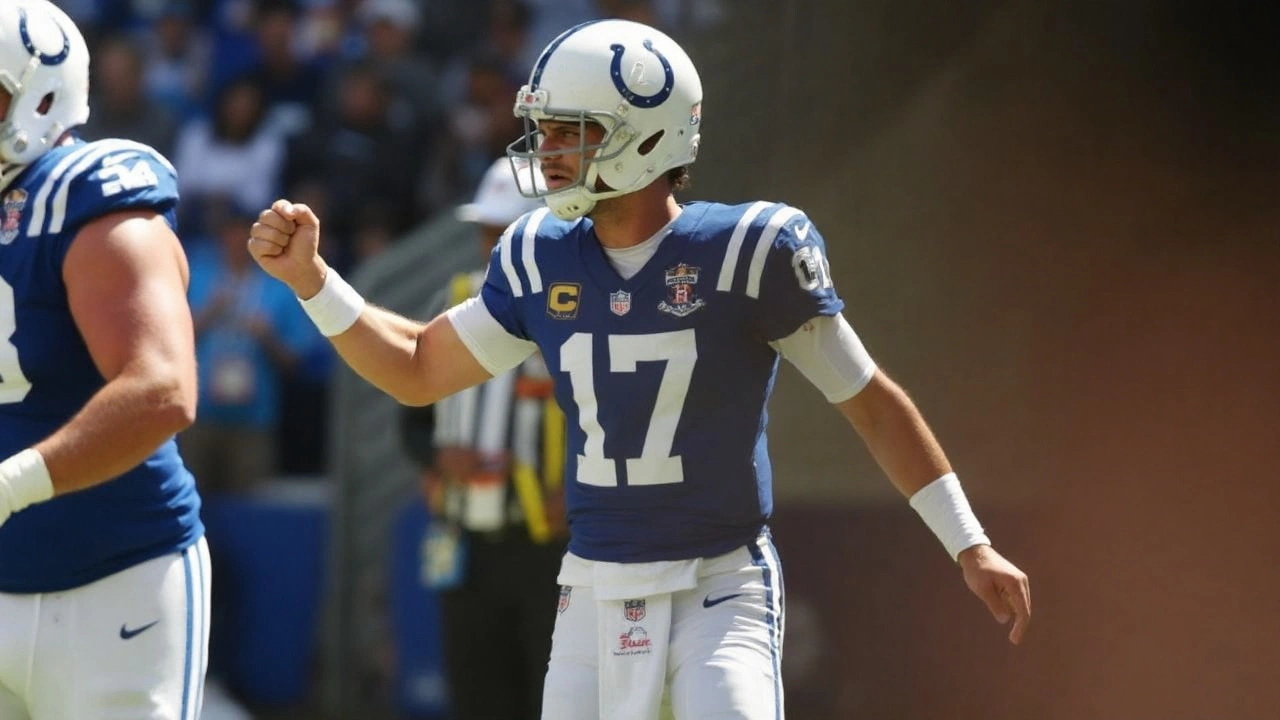Statement win: Colts throttle Dolphins, snap Week 1 curse
For a franchise that forgot what a clean season start felt like, this was a reset button smashed in front of 60,000 people. Daniel Jones, playing his first game in a Colts uniform, carved up the Miami Dolphins in a 33-8 rout at Lucas Oil Stadium, ending the NFL's longest active opening-day skid at 11 games and giving Indianapolis its first 1-0 start since 2013.
Jones won the starting job over Anthony Richardson nearly three weeks ago. On Sunday, he showed exactly why. He completed 22 of 29 passes for 272 yards, posted a career-high 197 passing yards in the first half alone, and produced three touchdowns — a 27-yard strike to Michael Pittman Jr. and a pair of 1-yard keepers that came off crisp short-yardage calls. He didn’t turn the ball over and he took just one sack behind a locked-in offensive line.
If you’re keeping score at home, the Colts scored on all seven of their possessions. No stalls. No panic. Just answers. That combination of pace, decisiveness, and efficiency is what head coach Shane Steichen has wanted to bottle since he arrived. His offense played on schedule, stayed ahead of the chains, and leaned into what Jones does best — quick reads, smart protections, and a steady drumbeat of easy completions that forced Miami to defend every blade of grass.
“It felt good to get a win, for sure,” Jones said after the game. “I think we played well as a team. It’s a good start. I think we feel good about the start. But I think everyone on our team is mature enough to know we have to continue to grow and improve, and I think that’s the mindset of our team now.”
The context matters. This was Jones’ first win as a starting quarterback since October 6 of last season with the New York Giants, the franchise that later released him. He arrived in Indianapolis with questions attached — durability, decision-making, pocket calm — and answered them with a mistake-free afternoon that looked more like a veteran settling into a system than a newcomer feeling it out.
The margin makes this more than a box-score bump. A 25-point win in Week 1 is a tone-setter. The Colts didn’t just handle business; they controlled the whole broadcast. They opened with tempo, leaned into motion and bunch looks, and used the run to create clean windows outside. When Miami tried to press and bring heat, the ball left Jones’ hand fast. When the Dolphins dropped deeper, the Colts took the underneath real estate and lived with eight-to-10-yard gains. That discipline kept drives alive and the defense fresh.
There was a rhythm to it. Early quick game to loosen the coverage. A couple of shot looks to threaten deep. Red-zone carries that weren’t cute — just efficient. The 27-yard touchdown to Michael Pittman Jr. was the kind of timing throw Indy has lacked in recent openers: Jones identified leverage pre-snap, held the safety with his eyes, and put the ball exactly where Pittman could rip through his break and finish.
Indy’s defense doesn’t get a highlight reel for holding a fast Dolphins offense to eight points, but that side of the ball set the table. Miami thrives on space and speed; the Colts limited the explosives, rallied to tackles, and forced long fields. Third downs swung Indy’s way as the pass rush affected timing and the secondary stayed patient. Complementary football isn’t a buzzword when every unit actually keeps the other out of harm’s way.
Special teams did their part, too. Kicker Spencer Schrader was perfect — seven-for-seven on kicks, including three field goals. It sounds basic, but nailing every operation in Week 1 is an edge. No short fields from missed kicks. No momentum swings. Just quiet points stacking up while the Dolphins searched for answers.
The streak that died Sunday had lived through multiple coaching staffs and quarterback rooms. It wasn’t one player’s problem. It was an organizational rut — a run of sloppy starts, turnovers, and long afternoons spent chasing. Breaking that pattern with a wire-to-wire performance matters inside a locker room. It tells veterans their prep translated. It tells young players the standard is the standard in real games, not just practice periods.
And it reflects the plan. Steichen didn’t ask Jones to be a hero. He asked him to be exact. The offense featured quick RPO looks, smart protections that slid to pressure, and a run game that forced Miami to respect downhill traffic near the goal line. Those two 1-yard Jones sneaks? They weren’t lucky bounces. They were trust calls, built on the offensive line winning leverage and Jones getting the snap out clean.
What changed for Jones? Speed of thought. His decision-making looked uncluttered — first reads when they were there, checkdowns when they weren’t, throwaways when the picture got muddy. No hero ball. The one sack he took came on a protected call where the coverage held; he ate the down and lived to throw the next pass. It’s the boring stuff that wins games in September and keeps you playing in January.
The numbers back up the eye test. Seven drives, seven scores. A clean turnover sheet. One sack. A first half that felt like a training tape for rhythm passing. The ball got spread around, and Pittman made the splash play. The rest of the receivers worked the middle and flats, keeping Miami guessing. Backs churned out steady yards and helped in protection. It looked like a team with answers for any down-and-distance.
Here’s how Indianapolis kept control all afternoon:
- Protected the football: Zero turnovers, no sudden changes.
- Controlled first down: Positive plays early, few second-and-longs.
- Red-zone urgency: Two quarterback keepers, no wasted motion near the stripe.
- Defensive patience: Limited explosives, rallied to tackles, won third down.
- Special teams certainty: Schrader’s 7-for-7 kept the scoreboard ticking.
Miami never found a groove. When they tried to speed the game up, Indy countered with press at the snap and clean tackling. When they slowed down to set up deep shots, the rush compressed the pocket. That’s not a fluke; it’s what happens when all three phases stack positive plays and deny freebies.
There’s also the human part. Jones arrived in a crowded room with Anthony Richardson, a former top pick and the face of the future. Winning that competition wasn’t about one impressive series in August; it was weeks of clean reps, command in meetings, and steady preseason drives. The Colts were careful with how they framed the decision publicly. Privately, Sunday showed what they valued — leadership, ball security, and how quickly the quarterback can get the offense in and out of the right play.
For Jones, the past year was loud. Injuries, a system shift, the scrutiny that comes with New York, and then a release. The Colts offered something different: an offense that matches his strengths, an offensive line that communicates well, and a coach who values precision more than fireworks. Week 1 will not erase the questions forever. It does buy trust — the kind that matters when the schedule tightens and teams have tape on your tendencies.
It also resets expectations for a locker room that’s been living in the shadow of that Week 1 streak. Ten straight seasons without a 1-0 start stretches across eras — from post-Luck uncertainty to year-to-year quarterback changes. This opener didn’t feel weighed down by any of that. It felt practical. It felt like a game plan tailored to the players they have right now, not an identity they wish they had.
Zoom out and the picture is even clearer. The Colts didn’t rely on one hot receiver or a fluky defensive score. They built drives. They got points. They backed that up with a defense that forced punts and swallowed yards-after-catch. That’s repeatable, which is what you want in September before weather, injuries, and scouting reports start stripping away your favorite calls.
A word on Pittman: the 27-yarder was more than a highlight; it was an indicator of trust. Jones threw the route before Pittman was out of his break, which only works if the receiver is exactly where he’s supposed to be. That’s timing you sharpen across camp and the preseason, not something you dial up cold. If that connection sustains, it changes how defenses treat the Colts on third-and-medium and in the low red zone.
The line deserves credit for the one-sack day. Communication picked up blitzes, the backs were sharp in pass pro, and Jones helped them by not holding the ball. That symbiosis is how you survive against teams that can run and hit. It showed up again on those short-yardage touchdowns, where pad level and surge won the snap.
Defensively, Indianapolis’ tackling stood out. Miami’s offense punishes poor angles and soft edges. The Colts’ corners and safeties made tackle-after-tackle in space, forcing second-and-7 instead of second-and-2. Up front, the rush didn’t always get home, but it moved the quarterback off his spot often enough to throw off timing. That’s how you turn a track meet into a possession game.
And the coaching? Steichen’s sequencing was sharp. Early horizontal stretches, then shots when safeties crept. Heavy formations near the goal line that sold run before punching in with the quarterback. Scripted plays that found easy completions and got Jones in rhythm. Nothing overly exotic — just plays that fit the players, run with conviction.
What does it mean for Week 2 and beyond? It’s a starting point, not a destination. The Colts will face defenses that take away the quick game and press the line. They’ll need more chunk plays, more answers on third-and-long, and continued discipline against pressure-happy fronts. But after years of stumbling out of the gate, Indianapolis finally has something solid to build on: clean football, a quarterback in command, and a locker room that saw its plan work on the field.
There will be a temptation to call this a redemption story for Jones. He’d probably settle for calling it 1-0. The tape gives the Colts a template. The confidence in the room gives them a shot to carry it forward. Now the test is consistency — the quiet trait that separates one big afternoon from a season that turns heads.


